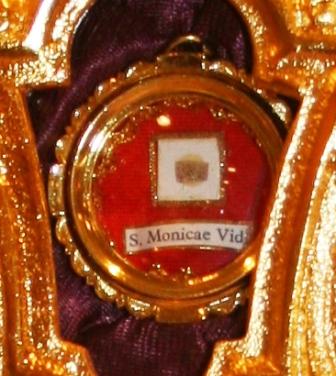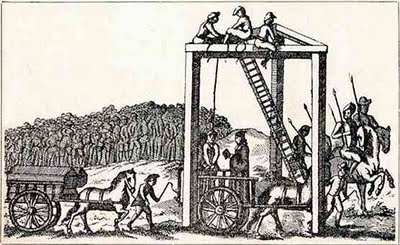 Today in the older, venerable, traditional Roman calendar, is the feast of St. Monica, widow and mother of St. Augustine of Hippo. In the post-Conciliar calendar her feast was transferred to the end of August. Monnica, is a spelling that conforms to her Punic origin.
Today in the older, venerable, traditional Roman calendar, is the feast of St. Monica, widow and mother of St. Augustine of Hippo. In the post-Conciliar calendar her feast was transferred to the end of August. Monnica, is a spelling that conforms to her Punic origin.
Monica died at Rome’s port Ostia, prevented from her return to N. Africa by a naval blockade. She caught a fever and passed away in 387, saying,
“Bury my body wherever you will; let not care of it cause you any concern. One thing only I ask you, that you remember me at the altar of the Lord wherever you may be.”
Much of St. Monica’s life is described by Augustine in Book 9 the Confessions. There are moving passages about her overcoming an addiction to alcohol, her dealings with a difficult and violent husband whom she helped to convert, her perseverance in promoting her son – whom she insisted be given the imperial name Augustus – and her good death. Augustine had her buried in Ostia and had a stone set up for her. After the sack of the area by the Visigoths in 410, he wrote to have her stone renewed. Though her body was subsequently moved to the Church of St. Augustine in Rome, her stone was discovered after WWII by children trying to set up a basketball hoop, a game they learned from American GI’s.
After Augustine ditched her in N. Africa to go alone to Italy, but she soon followed. In Milan, Monnica had some dealings St. Ambrose concerning her use of N. African customs in N. Italy, which scandalized people. He instructed her to do as they did and gave her the example of his own willingness to conform to the customs of Rome when he was in Rome. Whence the famous proverb. She must have been a formidable woman to have garnered attention from Ambrose. Furthermore, Augustine himself gives her an important role in his early philosophical dialogues, an unprecedented role for a woman in ancient literature. As Augustine and his companions were preparing for baptism during their working retreat at Cassiciacum, Monica would sometimes be asked – as the baptized person present to answer certain questions. She, therefore, exemplified something of Augustine’s homo spiritalis he would develop later, a figure who might even correct a bishop.
In life, Monica was a fascinating woman, a loving wife and mother, and after death a strong intercessor.
Here is a photo of a first class relic of St. Monica, in my possession.

Today is also the feast of several English martyrs.
Who would like to have a go at this entry from the 2005 Martyrologium Romanum?
6. Londinii in Anglia, sanctorum presbyterorum martyrum Ioannis Houghton, Roberti Lawrence et Augustini Webster, priorum cartusiarum Londiniensis, Ballavallensis et Axholmiensis, atque Richardi Reynold, ex Ordine Sanctae Brigittae, qui, cum fidem patrum impavide professi essent, Tyburni ad supplicium laniatus tracti sunt sub Henrico rege Octavo. Cum eis beatus Ioannes Haile, presbyter, parochus loci Isleworth prope urbem, eodem patibulo suspensus est.



































Thank you for the post on St. Monica and for showing your precious relic. St. Monica hears from me often regarding children and family who have strayed.
I might as well take a stab at it.
At London, in England, [the feast] of the holy priest-martyrs John Houghton, Robert Lawrence, and Augustine Webster, priors of the Carthusian houses* of London, Ballavale[?**], and Axholm, and of Richard Reynolds, of the Order of Saint Bridget, who, when they had professed the faith of the fathers fearlessly, were dragged [or, perhaps, “drawn” here] to the punishment of mangling [or, perhaps, “being torn to pieces”] at Tyburn, under King Henry the Eighth. With them Blessed John Haile, priest, pastor of the place Isleworth, near the city, was hung from the same beam [or, “gibbet”]. [After “suspensus” I assume the ablative is better translated “from” than “with”.]
* I assume the feminine “cartusiarum” agrees with an implied “domuum” vel sim.
** I looked in Graesse’s Orbis Latinus and couldn’t find Ballavallensis, alas. The closest thing I could find was Ballavale, on the Isle of Man.
I won’t even attempt a translation-I’d probably screw it up.
Nice icon of St. Monica, Father Z-and you’re sooo lucky to have a first-class relic of her!
Rather coincidental that today is also the feast day of the ‘Proto-Martyrs of the English Reformation’ (St. John Houghton and Companions). Right now I’m reading aloud (call me weird if you must) ‘The King’s Achievement’, by Msgr. Robert Hugh Benson. It’s about the suppression of the Religious Houses of England in the reign of Henry VIII, and its effect on one [fictional] Catholic English family. It also mentions such ‘real-life’ people as St. John Fisher, St. Thomas More, and today’s martyrs.
At London in England, [the feast of] the holy priest-martyrs, John Houghton, Robert Lawrence and Augustine Webster, priors [respectively] of the London, Beauvale and Axholme Charterhouses, and of Richard Reynold[s], of the Order of Saint Birgitta, who, when they had fearlessly professed the faith of [their]fathers, were drawn to execution by tearing [hanging, drawing and quartering] at Tyburn under King Henry VIII. With them Blessed John Haile, presbyter, parish priest of the town of Isleworth near the city, was hanged from the same gibbet.
Ora Pro Nobis S. Monicae!
St. Monica is commemorated on Orthodox calendars on 4 May, but to my knowledge there is no liturgical text for this.
Alas, there is no appropriate service in the General Menaion (corresponding to the Common of the Saints) for her.
Is there an English translation of the 2005 Martyrology? I know of certain houses using one, but it does not seem to be produced commercially…
In fact, is it possible to view the Latin text online?
Jesus commanded the women to weep not for him, but for their children. St. Monica wept and prayed for 30 years and lived to see St. Augustine’s conversion.
Father Z, when you went to London the last time, did you go to St. Etheldreda’s Church in Spanish Place? There’s a big stained-glass window depicting the Proto-Martyrs (the three Carthusians, Richard Reynolds the Brigittine monk, and John Hale, the secular priest). There is also a statue of St. John Houghton that is on the wall facing the nave.
I didn’t go to it on any of my visits to England, but on my last one in 1999 I picked up one of those cool Pitkin Guidebooks that related the history of the chapel. Wonderful pictures of the interior! What a beautiful place that was, and still is!
Irishgirl: Yes, I visited St. Etheldreda. And I think we need more baby girls named Etheldreda.